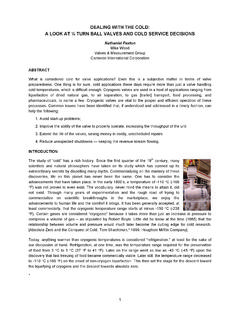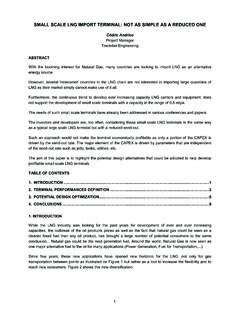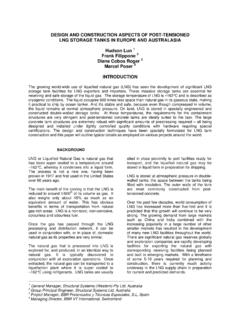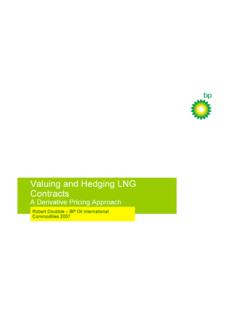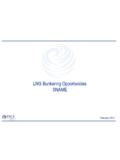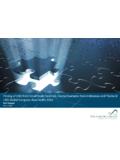Transcription of NATURAL GAS LIQUEFACTION TECHNOLOGY FOR …
1 1 NATURAL GAS LIQUEFACTION TECHNOLOGY FOR floating LNG FACILITIES Dr. Justin D. Bukowski Lead Process Engineer Dr. Yu Nan Liu Technical Director, LNG Dr. Mark R. Pillarella Senior Process Manager, LNG Stephen J. Boccella Lead Mechanical Design Engineer William A Kennington LNG Major Account Manager Air Products and Chemicals, Inc. Allentown, PA, USA 18195-1501 KEYWORDS: FLNG, refrigeration cycles, DMR, nitrogen recycle ABSTRACT Forecasts for the LNG industry indicate that a large segment of growth will occur through floating LNG (FLNG) development. FLNG facilities present special challenges over those facilities on land. Among these challenges are the response of equipment and processes to wave induced motion of the vessel, weight and space limits for the process equipment on the vessel topsides, difficulty of equipment maintenance and repair or replacement, handling of flammable component inventories, and corrosion.
2 Meeting these challenges requires a mix of analysis, testing, and innovation. To qualify coil wound heat exchangers (CWHE) for FLNG applications, Air Products performed an extensive design verification program. The program included rigorous mechanical analysis of the exchanger, as well as experimental testing of components which were not amenable to analysis. The program also addressed the effects of motion on mixed refrigerant LIQUEFACTION process performance through an integrated analytical and experimental investigation of two-phase flow within a CWHE. The results of the mechanical and process verification programs have been applied to CWHE designs for FLNG, including the Shell Prelude FLNG and Petronas FLNG 1 projects.
3 Several process cycles suitable for floating LNG applications are presented. Mixed Refrigerant (MR) processes combine high production and high efficiency for FLNG applications. An all-nitrogen refrigeration process eliminates hydrocarbon refrigerant inventory with an LNG production capacity greater than 1 MTPA in a single NATURAL gas train. Several different precooling schemes are discussed, with advantages and disadvantages of each. 1 INTRODUCTION The LNG industry has seen robust growth in the past several decades, from a worldwide demand of 50 million tons in 1990 to over 240 million tons in 2011.[1] This remarkable growth was primarily supported by the monetization of the world's large conventional gas fields.
4 Future growth of the LNG industry is expected to be divided between the remaining conventional fields and two sources that up to now have been considered too difficult or expensive to monetize: unconventional gas such as shale gas and coal bed methane, and deep offshore fields. The phenomenal growth of shale gas production assures that new land-based LNG facilities will continue to be constructed for the foreseeable future as these resources are exploited. At the same time, the development of remote offshore gas reserves will require the construction of floating LNG (FLNG) facilities, as many of these fields are located far enough offshore or in water too deep to make pipeline delivery to a land-based plant economically attractive.
5 2 The design, construction and operation of an LNG facility on a floating vessel presents a number of special challenges when compared to a land-based plant: ocean induced vessel motions, equipment size/weight/layout concerns, equipment marinization and the harsh marine environment. Wave and wind induced vessel motions must be considered in the design of the process equipment both from mechanical integrity and process operation viewpoints: The required strength and fatigue resistance of the equipment will be determined by the severity of the vessel motion, which itself is a consequence of the vessel size and design as well as the local sea conditions.
6 The equipment design must not only consider the typical conditions while the vessel is on station, but also motion while in transit to the site, severe storms, and survivability of catastrophic events such as blast loads and damaged vessel list. Process equipment with two-phase flow may be affected by the vessel motion, and the possible reduction of performance must be considered in the process design to ensure that the facility can meet operational targets. Compared to a land-based LNG facility, weight and space limits for the process equipment are very important for an FLNG facility. The space limitations can lead to difficulty with equipment maintenance, and repair or replacement can be difficult as well, even before considering the remote location.
7 The vessel confines make it difficult to separate the sections of the facility containing flammable inventories and those locations which are frequently occupied by personnel. This and the desire to minimize the risk of catastrophic loss therefore suggest that flammable inventory on the vessel should be minimized. Process selection is an important first step for reducing inventory. Another important consideration is the corrosive marine environment. The continual salt water spray upon equipment and piping is a condition which must be taken into account when material selections are made. While land-based cryogenic equipment may be constructed from aluminum, FLNG equipment may use other chloride resistant materials such as grade 316L stainless steel.
8 These challenges influence the selection of the FLNG LIQUEFACTION process. Adapting the land-based LNG process to the difficult marine environment requires innovation to meet these challenges, and the risks added by the innovations must be carefully managed by analysis and testing. This paper will discuss specific benefits of various process cycles for FLNG service, with an emphasis on the dual mixed refrigerant (DMR) cycle options. 2 LIQUEFACTION HEAT EXCHANGERS FOR FLNG In an LNG process, the cooling and LIQUEFACTION of the NATURAL gas takes place in one or more heat exchangers, depending on the cycle selected. All of the following processes utilize a coil wound heat exchanger (CWHE) as the equipment in which the LIQUEFACTION takes place.
9 CWHEs can be manufactured to provide high LNG capacity in a single train, while having excellent turndown capability. By their basic design they are robust and have been proven to be able to tolerate the high thermal stresses created by the high heat transfer rates when the NATURAL gas is condensed. In addition, in the very rare case where tube leaks occur, the leak is fully contained by the pressure vessel shell of the CWHE, preventing leakage of NATURAL gas or refrigerant directly to the environment. Unlike other types of heat exchangers, which can leak directly to the environment and therefore must be shut down immediately, a CWHE may continue to operate until such time as a repair can be scheduled, typically during a major LNG facility maintenance overhaul.
10 For FLNG, this dual containment provides an extra level of protection. Air Products has performed an extensive mechanical design verification program to qualify our CWHEs for FLNG applications, including both rigorous analysis as well as experimental testing of mechanical 3 components.[2] The results of the mechanical and process verification programs have been incorporated into Air Products' CWHE designs for FLNG, including the Shell Prelude FLNG and Petronas FLNG 1 projects. For FLNG service, the CWHE design uses a stainless steel shell for strength and corrosion resistance, with aluminum internals to maintain excellent heat transfer performance and lower exchanger weight.
